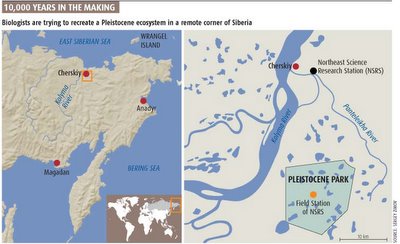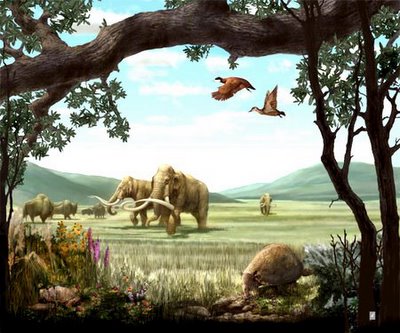"Zimov wants to answer some fundamental questions about the impact early modern humans had on the environment."

[Image: New Scientist].
"During the late Pleistocene, north-eastern Siberia was part of the world's largest ecosystem, stretching from western Europe across the Bering Strait to Canada and from the Arctic to northern China – half the land area of the planet."
It was densely populated with "huge herds of herbivores – mammoths, bison, elk, woolly rhinos, yaks, saiga, horses, reindeer, musk oxen and moose" – till 10,000 years ago, when "the large animals died out... and the grassland that supported them also disappeared, replaced by mossy forests and tundra."
So what happened? Zimov blames the arrival of human beings (I'm imagining a century or two of intensely aromatic, Conan the Barbarian-style outdoor barbecues), and, to prove this, he's organized the Pleistocene Park.
The park will sit "in 160 square kilometres of meadows, forests and willow shrublands in the Kolyma river basin," a "remote corner of Siberia, once a final destination for exiled Soviet dissidents."
It may even be re-populated with cloned mammoths; then the ecological experiment will begin.

[Image: Spotted at Pruned].
Upon further reflection, I'm thinking at least four things: 1) it seems a very odd coincidence that the exact same thing is being proposed right now for central North America; 2) why only the Pleistocene? let's rebuild the Hadean era, or bring back some Devonian seas; 3) why does it have to be an ecosystem? why can't we rebuild the architectural world of, say, the Holy Roman Empire? or pre-war Europe? cool roads and little chapels everywhere, tiny villages – the Minoan labyrinth!; and 4) if a forward-thinking restaurant did this, they'd have the most amazing supply of ingredients in the world.
[For other preserved landscapes, see BLDGBLOG's Silicon Gardens].
No comments:
Post a Comment